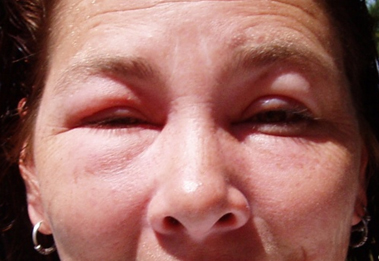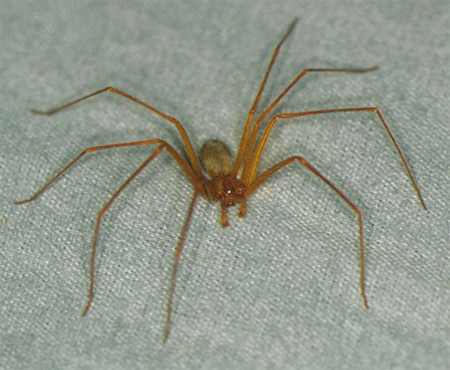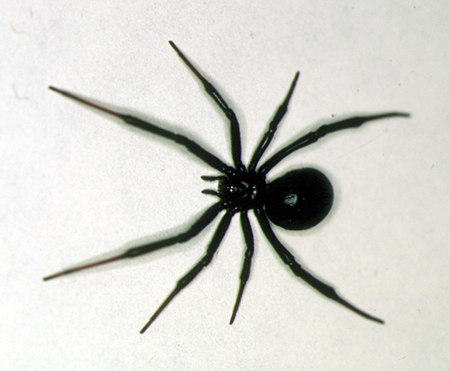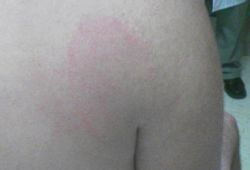Approach
Diagnosis is generally based on history, physical examination, and clinical judgement. For stinging insect allergy, tests are available to confirm the diagnosis and identify the specific species that caused the reaction. The first step is discerning by history whether the reaction is severe (moderate-to-severe anaphylaxis). Any suspicion of anaphylaxis should be further evaluated by an experienced allergy consultant. At the time of the bite or sting, anaphylaxis requires immediate action. Less severe reactions can be treated with comforting measures.
Determining severity of initial reaction
Local (normal) reactions
Usually present with oedema, itching, and pain.[24][Figure caption and citation for the preceding image starts]: Periorbital swelling 24 hours after yellow jacket sting above right eyeCourtesy of Tom Morrissey [Citation ends].

Acutely, spider bites may show one or two small fang marks.
Additional symptoms include wheal and flare formation, warmth, and pruritus at the bite/sting site.[31][Figure caption and citation for the preceding image starts]: Wheal formation following wasp stingCourtesy of Theodore Freeman [Citation ends].

Normally self-limiting and confined to skin and soft tissues.
May be difficult or impossible to distinguish between an inflammatory (allergic) and an infectious (cellulitis) reaction to a bite or sting after 3-5 days, but severe swelling and induration in the first 24-48 hours after a sting is typical of an allergic large local reaction even when there is apparent lymphangitis that is inflammatory, not infectious.
If there is no improvement after a few days, a secondary infection may have developed and may be associated with constitutional symptoms such as fever.
Large local reactions begin 6-12 hours after a sting, peak in 2-3 days, and resolve in 3-10 days.
Systemic reactions
Severity of anaphylaxis can range from any combination of urticaria and angio-oedema, bronchospasm, oedema of the large airway (e.g., throat tightness), or hypotension (dizziness) to life-threatening anaphylaxis involving respiratory failure and cardiovascular collapse.[3][4][5][32][33]
Anaphylaxis may be diagnosed based on either the National Institute of Allergy and Infectious Diseases (NIAID) 2006 criteria or the World Allergy Organization (WAO) 2020 criteria. Using the NIAID criteria, which have been more extensively validated, anaphylaxis is likely when any one of the following three criteria is satisfied:[1][3][4][5]
Acute onset of a reaction that involves the skin, mucosal tissue, or both with either respiratory involvement or reduced blood pressure and/or associated symptoms of end-organ dysfunction
Two or more of the following occur rapidly after exposure to a likely allergen: (i) involvement of skin-mucosal tissue, (ii) respiratory involvement, (iii) reduced blood pressure or associated symptoms, or (iv) gastrointestinal symptoms
Reduced blood pressure after exposure to a known allergen.
History
In addition to determining symptoms of local reactions and symptoms of anaphylactic reactions, it is important to elicit historical factors such as time course of symptom onset, cofactors that can affect the course of a reaction, behaviours that predispose to insect exposure, and witnessing of bites. The history should include the what, where, when, and how of the sting; enquiring about the number of exposures and previous reactions; discovering whether the bite or sting was witnessed; determining how much time has passed since the encounter; eliciting what the patient was doing during and after the exposure; and determining whether the patient has taken any drugs or performed any self-treatments.
Time course of onset
Some bites and stings (e.g., horsefly bites, wasp stings) result in immediate pain and local injury/bleeding. Others, like tick bites, are not felt immediately. Rarely, recluse spider bites can develop slow, but relentlessly progressive, local tissue necrosis.[Figure caption and citation for the preceding image starts]: Brown recluse spider (Loxosceles species)Courtesy of Rick Vetter [Citation ends].
 [Figure caption and citation for the preceding image starts]: Lesions from reported brown recluse (Loxoscelesspecies) envenomationCourtesy of Theodore Freeman [Citation ends].
[Figure caption and citation for the preceding image starts]: Lesions from reported brown recluse (Loxoscelesspecies) envenomationCourtesy of Theodore Freeman [Citation ends]. [Figure caption and citation for the preceding image starts]: Lesions from reported brown recluse (Loxosceles species) envenomationCourtesy of Theodore Freeman [Citation ends].
[Figure caption and citation for the preceding image starts]: Lesions from reported brown recluse (Loxosceles species) envenomationCourtesy of Theodore Freeman [Citation ends]. Fire ant stings cause localised tissue necrosis and the formation of a characteristic sterile pustule about 24 hours after the sting.[22][23][Figure caption and citation for the preceding image starts]: Pseudopustule formation following fire ant stingCourtesy of Theodore Freeman [Citation ends].
Fire ant stings cause localised tissue necrosis and the formation of a characteristic sterile pustule about 24 hours after the sting.[22][23][Figure caption and citation for the preceding image starts]: Pseudopustule formation following fire ant stingCourtesy of Theodore Freeman [Citation ends].
There may be delayed reactions to substances introduced from the bite/sting and symptoms, which may not be noticed until hours/days later. Infections transmitted by the bite are also often not felt immediately.
Serum sickness is an uncommon delayed reaction, usually occurring about a week after envenomation. Symptoms include fever, myalgias, arthralgias, rash, adenopathy, and headache.
Very rarely, vasculitis and immunological complications can lead to glomerulonephritis, Guillain-Barre syndrome, haemolytic anaemia, thrombotic thrombocytopenic purpura, transverse myelitis, optic neuritis, and other neuropathies.[6][7][8][9]
Rarely, insect stings can lead to biphasic allergic reactions or symptom recurrence after resolution of the initial presentation can occur.[34][35][36] There are limited data to predict the risk of biphasic or protracted anaphylaxis. The severity of anaphylaxis and/or the need for >1 dose of adrenaline (epinephrine) are considered risk factors for biphasic reactions.[2]
Past medical history may reveal previous exposures (history of severe reaction, multiple previous exposures). It may also reveal underlying chronic medical conditions such as immunocompromised states that may place an individual at higher risk for secondary infection following an insect bite/sting. Other chronic medical conditions such as underlying asthma or cardiovascular disease may increase the risk due to an individual’s inability to tolerate symptoms of anaphylaxis or its treatments.
Drug history may reveal use of medications that blunt treatment effects (e.g., beta-blockers).
Physical examination
Most bites and stings only cause dermatological manifestations of pain, itching, or rash. However, a directed physical examination done immediately after a sting/bite must first focus on more immediate threats and evaluate the respiratory, cardiovascular, and gastrointestinal systems.
If the patient appears stable, the directed examination must include assessment of at least the following systems:
Cardiovascular: assess for heart rate, rhythm, murmurs, blood pressure, pulse strength, capillary refill time, colour of extremities, temperature of extremities. Black widow spider bites can cause chest pain which can confuse the diagnostic picture; myocardial ischaemia should be ruled out.
Respiratory: assess for respiratory rate, work of breathing, oxygen saturation, stridor (usually inspirational, heard over neck), wheeze (usually expiratory, heard over lungs), rales or crackles (sign of cardiovascular failure).
Neurological: assess for alertness, sensorium clarity, autonomic nervous system instability (fluctuating pulse or blood pressure, localised or generalised diaphoresis), tremors, cramps, fasciculations, localised pain, generalised pain. Black widow spider bites may cause neurological effects, including severe pain and muscle spasms in the affected limb or in a generalised fashion.[24] The onset of symptoms is generally within 30-60 minutes, and last 24-48 hours.[37][Figure caption and citation for the preceding image starts]: Black widow (Latrodectusspecies); the red hourglass marking is not always this shape and may not be presentCourtesy of Rick Vetter [Citation ends].
 [Figure caption and citation for the preceding image starts]: Black widow (Latrodectus species)Courtesy of Bill Banner [Citation ends].
[Figure caption and citation for the preceding image starts]: Black widow (Latrodectus species)Courtesy of Bill Banner [Citation ends].
Gastrointestinal/genito-urinary: assess for presence, location, and quality of abdominal pain (rigidity, guarding, rebound tenderness, uterine cramping); presence of bowel sounds. Black widow spider bites may present with acute abdominal cramping mimicking an acute surgical abdomen.[24][37]
Dermatological assessment
Is the bite or sting site visible? Is there a large skin defect? Are fang marks visible?
What is the location and number of bites or stings?
Is there a stinger still present?
Is the rash raised and itchy (wheals/urticaria are typical for Hymenoptera stings)? [Figure caption and citation for the preceding image starts]: Wheal formation following wasp stingCourtesy of Theodore Freeman [Citation ends].

Is there local redness or swelling? [Figure caption and citation for the preceding image starts]: Periorbital swelling 24 hours after yellow jacket sting above right eyeCourtesy of Tom Morrissey [Citation ends].

Is there diffuse or generalised skin rash?
Does the appearance resemble cellulitis (if more than 2 days after bite/sting)?
Is there evidence of abscess formation (subcutaneous or deep-tissue fluctuance)?
Is there a shape or pattern to the rash? Linear raised rash may represent urticating caterpillars, or a contact dermatitis (like poison ivy) rather than an insect sting.
Are pustules present? A ring of small pustules is indicative of fire ant stings. [Figure caption and citation for the preceding image starts]: Pseudopustule formation following fire ant stingCourtesy of Theodore Freeman [Citation ends].

Bullseye-shaped rash following tick bites is indicative of Lyme disease. [Figure caption and citation for the preceding image starts]: Erythema migrans of Lyme diseaseCourtesy of Janak Koirala, MD, MPH; Tin Han Htwe, MD; and Christian Speil, MD [Citation ends].

Involvement of palms and soles following tick bites is indicative of Rocky Mountain spotted fever.
Is there necrosis? Rarely, recluse spider bites can develop slow, but relentlessly progressive, local tissue necrosis. [Figure caption and citation for the preceding image starts]: Brown recluse spider (Loxosceles species)Courtesy of Rick Vetter [Citation ends].
 [Figure caption and citation for the preceding image starts]: Lesions from reported brown recluse (Loxoscelesspecies) envenomationCourtesy of Theodore Freeman [Citation ends].
[Figure caption and citation for the preceding image starts]: Lesions from reported brown recluse (Loxoscelesspecies) envenomationCourtesy of Theodore Freeman [Citation ends]. [Figure caption and citation for the preceding image starts]: Lesions from reported brown recluse (Loxosceles species) envenomationCourtesy of Theodore Freeman [Citation ends].
[Figure caption and citation for the preceding image starts]: Lesions from reported brown recluse (Loxosceles species) envenomationCourtesy of Theodore Freeman [Citation ends].
Tryptase levels
In all cases of sting anaphylaxis, drawing blood to obtain serum tryptase levels within 1-5 hours of onset (ideally within 1-2 hours) of symptoms can verify that mast cells were activated and may help establish a diagnosis of anaphylaxis.
Raised baseline serum tryptase is closely correlated with the risk of severe anaphylaxis to insect stings, and checking baseline serum tryptase at a later date is recommended for individuals with a prior history of severe anaphylaxis from Hymenoptera stings particularly in those who present with a history of hypotension and/or absence of urticaria as these may be indicators of an underlying mast cell disorder.[3][5][32][38]
Sensitivity testing
Sensitivity testing, including venom skin tests or in vitro serological tests, are indicated in individuals who have suffered sting-triggered anaphylaxis to determine what venom allergen they are sensitised to and to inform their immunotherapy treatment prescription.[19][32][39] This should not be done too soon after the reaction, as depletion of mediators from the reaction may result in a false-negative response. Skin testing should be delayed for 2-6 weeks after the acute event. Due to the high rate of asymptomatic sensitisation (i.e., evidence of venom-specific IgE without a correlating clinical history of venom allergy) in the general population (up to 20% of adults), generalised screening is impractical and not recommended.[15][32][40][41]
Full blood count
Cellulitis or infected bites/stings will cause raise of white blood cell levels.
Use of this content is subject to our disclaimer